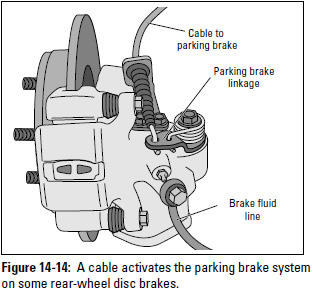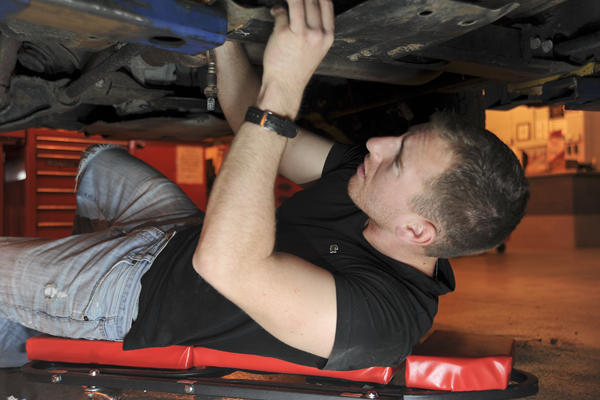The parking brake, or emergency brake, is usually attached to a car’s rear wheels. On vehicles with rear drum brakes, the parking brake is usually attached with cables to the rear brakes, as shown in Figure 14-10. These are called integral parking brakes (see Figure 14-11). Although most newer vehicles have self-adjusting systems, if your vehicle doesn’t you can easily adjust the cables, which run underneath the car, by turning a screw that controlsthe tension on the cable.
| [Asset Included(Id:1199451914093;Type:maImageAsset)][Asset Included(Id:1199451914129;Type:maImageAsset)] |
On other vehicles with drum brakes, different devices do the same job. Some parking brakes on vehicles with rear-wheel drive are linked to the transmission, and rather than activating the rear brakes, they stop the driveshaft from turning the rear wheels. On these brakes, shown in Figure 14-12, the band and lining are attached to a drum on the transmission. When you pull the lever, the band squeezes the lining against the drum, and the driveshaft stops turning. When a transmission-type parking brake doesn’t seem to beperforming properly, have a professional check it.
| [Asset Included(Id:1199451914165;Type:maImageAsset)][Asset Included(Id:1199451914204;Type:maImageAsset)] |
If you have rear disc brakes on your car, it may incorporate a parking brake that works like a mini-drum brake attached to the rear wheels (see Figure 14-13). Most parking brake systems for vehicles with rear disc brakes, however, employ the disc brake itself. Vehicles with disc brakes on both front and rear wheels use a cable to activate their parking brakes. You can see how it all hooks upin Figure 14-14.
 |
From Auto Repair for Dummies, copyright © 2009 by Wiley Publishing, Inc., Indianapolis, Indiana. Used by arrangement with John Wiley & Sons, Inc.











